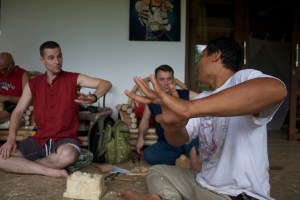The Surprises of Surprise

Re-entry is interesting. And by interesting, I mean full of surprises. Surprise is also, itself, interesting. And therefore surprise is…surprising.
I’m not just playing circular word games. Surprise, like accidents, cannot ever be fully predicted. For example, when thinking about my reactions to coming back to the US after studying abroad, I could see some likely outcomes, and was therefore relatively prepared for those. But re-entry is surprising (=interesting (=surprising)). No matter how much I might look ahead or prepare, there will always be something surprising, something I won’t see coming. Yet somehow I’m always surprised by the fact that I get surprised. And that’s interesting.

It was surprising to me to find the way in which the known parts of my life at home were feeling foreign. Suddenly awake and confused with jetlag at 4am, I looked at everything in my room. “This is mine. I chose these things. This is the way they look.” Somehow it felt all very faraway. Recognizable, yes; but the thread of connection was difficult to perceive.

A few days have passed, and the feeling has largely diminished. And as my home reality takes precedence, I want to record a list of sights and impressions from my trip before they, too, seem distant and difficult to connect with.
Sights and Sites

(These are in no particular order)
° Sidewalks are segmented, and some stones have metal handles. The walkway often has several stones which have fallen in, revealing the water channels beneath. These channels are all connected to each other.

° Sarongs, sarongs, sarongs! They are commonly sold in printed, batik, or ikat fabrics.
° Shops that are all selling mostly the same things, right next to each other. Bargaining is the way things are done. “I give you good price, for luck.” Keep your sense of humor.


° The lack of idle chatter about first world problems, celebrities, and so on. How refreshing!

This is not to say I didn’t witness some very odd Javanese game shows and soap operas on mute in the central room at the hotel.
° Coconut, banana, papaya, and jackfruit trees are widespread. There was even a mangosteen tree on the grounds of the hotel! Thankfully durian were more rare.

° The frequent appearance of the words “spa” and “villa.” These words are replacing the words “rice paddies” with increasing frequency.
° Bottles of petrol for sale on the side of the road. You can buy in either kecil (small) or besar (large). The large fills your motor scooter tank, and costs 1400 rupiah. That’s about $1.
° Very noticeable is the red and grey and black coloration of so many housing compounds and temples.

° I enjoyed the moments where I started to understand what I was seeing. Just the beginning of understanding really, like when you’re learning a language, and every so often you recognize a word instead of only hearing sounds. The positions of the golden statues I’d seen along the road when I arrived were suddenly recognizable choreography. When looking at a painting or temple figure, I could recognize a character or sometimes a part of the story of the Mahabharata or Ramayana. What was aesthetic appreciation at first now carries more context and has more meaning.

° Black and white checkered sarongs wrapped around banyan trees, signifying they have a spirit and are protected. These sarongs also sometimes appear on certain statues. Balinese religion is a fascinating mix of Buddhism, Hinduism, and animism. Good and evil are both acknowledged as forces in the world—our purpose is to keep them in balance.



° Offerings are everywhere. Not just on the front porch, or in a little box at the corner of a building. Even in the middle of the supermarket, there are offerings.
° Wayan Wija talking to us about his role as a dalang (puppeteer). The dalang is also a sort of a priest and philosopher. He often deals in ancient stories that bring to life questions of philosophy, while also providing something for the eyes to enjoy. Wija says that even in Bali, so many now are filled up with material concerns, few have room in them for philosophy.


° Parisawata tour buses choke the small, winding back roads… Chinese and Australian tourists wander in downtown Ubud… white people look hot and uncomfortable while some Balinese are wearing jackets, because it’s cold to them.
° The smell of cempaka incense.
° Frogs performing their own version of a kecak or a gamelan. All three—frogs, chant, and orchestra—produce interlocking sounds that are beautifully trance-like and transporting. But how do the frogs all know to cease at same time?

° Our mask carving teacher talked to us about the meaning of the progression of the characters in the one-man topeng pajegang. The progression of the story mirrors the the entire life of a person. The dancer moves from the rough path of youth with strong will and body (topeng keras) to the strength of mind and experience (topeng tua) to the enrichment of life gained from sharing experience (topeng penasar) to the leadership of others (topeng dalem) and finally to success and prosperity (topeng sida karya).



This trip was made possible in part by a professional development grant from the Regional Arts and Culture Council.


Well I’ll be damned, what a rich life you’ve lived. Enjoyed the photos and the memoir.
thanks for reading! glad you enjoyed.
I feel as if I’ve been with you on this trip to Bali in such a beautiful way. Thank you, Tony for sharing this with us!
Thanks, Nicole! It’s great fun to share!